LightCF-Net: A Lightweight Long-Range Context Fusion Network for Real-Time Polyp Segmentation
Abstract
1. Introduction
- A novel and efficient lightweight long-range context fusion network, named LightCF-Net, has been proposed for real-time polyp segmentation.
- A novel FAEncoder module has been designed, integrating Large Kernel Attention (LKA) with channel attention mechanisms to extract deep representational features of polyps and discover long-range relationships.
- A novel VAM module has been designed within the skip connections to model long-range contextual dependencies from features extracted by the encoder and to reduce background noise interference by focusing on key information through the attention mechanism.
- Extensive evaluation of the proposed method on four renowned polyp segmentation datasets showed that it surpasses the most advanced lightweight polyp segmentation networks in terms of operational efficiency and segmentation accuracy.
2. Related Work
3. Materials and Methods
3.1. Datasets
3.2. Overall Structure
3.3. Fusion Attention Encoder (FAEncoder)
3.4. Visual Attention Mamba Module (VAM)
3.5. Pyramid Split Attention Module (PSA)
4. Results
4.1. Implementation Details
4.2. Loss Function
4.3. Comparative Experimental Results and Analysis
4.4. Ablation Study
5. Discussion
6. Conclusions
Author Contributions
Funding
Institutional Review Board Statement
Informed Consent Statement
Data Availability Statement
Conflicts of Interest
References
- Siegel, R.L.; Giaquinto, A.N.; Jemal, A. Cancer statistics, 2024. CA Cancer J. Clin. 2024, 74, 12–49. [Google Scholar] [CrossRef] [PubMed]
- Kolligs, F.T. Diagnostics and epidemiology of colorectal cancer. Visc. Med. 2016, 32, 158–164. [Google Scholar] [CrossRef] [PubMed]
- Haggar, F.A.; Boushey, R.P. Colorectal cancer epidemiology: Incidence, mortality, survival, and risk factors. Clin. Colon Rectal Surg. 2009, 22, 191–197. [Google Scholar] [CrossRef] [PubMed]
- Nishihara, R.; Wu, K.; Lochhead, P.; Morikawa, T.; Liao, X.; Qian, Z.R.; Inamura, K.; Kim, S.A.; Kuchiba, A.; Yamauchi, M.; et al. Long-term colorectal-cancer incidence and mortality after lower endoscopy. N. Engl. J. Med. 2013, 369, 1095–1105. [Google Scholar] [CrossRef] [PubMed]
- Zheng, B.; Rieder, E.; Cassera, M.A.; Martinec, D.V.; Lee, G.; Panton, O.N.M.; Park, A.; Swanström, L.L. Quantifying mental workloads of surgeons performing natural orifice transluminal endoscopic surgery (NOTES) procedures. Surg. Endosc. 2012, 26, 1352–1358. [Google Scholar] [CrossRef] [PubMed]
- Mette Asfeldt, A.; Straume, B.; Paulssen, E.J. Impact of observer variability on the usefulness of endoscopic images for the documentation of upper gastrointestinal endoscopy. Scand. J. Gastroenterol. 2007, 42, 1106–1112. [Google Scholar] [CrossRef] [PubMed]
- Leufkens, A.M.; Van Oijen, M.G.H.; Vleggaar, F.P.; Siersema, P.D. Factors influencing the miss rate of polyps in a back-to-back colonoscopy study. Endoscopy 2012, 44, 470–475. [Google Scholar] [CrossRef] [PubMed]
- Mamonov, A.V.; Figueiredo, I.N.; Figueiredo, P.N.; Tsai, Y.H.R. Automated polyp detection in colon capsule endoscopy. IEEE Trans. Med. Imaging 2014, 33, 1488–1502. [Google Scholar] [CrossRef] [PubMed]
- Tajbakhsh, N.; Gurudu, S.R.; Liang, J. Automated polyp detection in colonoscopy videos using shape and context information. IEEE Trans. Med. Imaging 2015, 35, 630–644. [Google Scholar] [CrossRef] [PubMed]
- LeCun, Y.; Bottou, L.; Bengio, Y.; Haffner, P. Gradient-based learning applied to document recognition. Proc. IEEE 1998, 86, 2278–2324. [Google Scholar] [CrossRef]
- Vaswani, A.; Shazeer, N.; Parmar, N.; Uszkoreit, J.; Jones, L.; Gomez, A.N.; Kaiser, L.; Polosukhin, I. Attention is all you need. arXiv 2017, arXiv:1706.03762. [Google Scholar]
- Long, J.; Shelhamer, E.; Darrell, T. Fully convolutional networks for semantic segmentation. In Proceedings of the IEEE Conference on Computer Vision and Pattern Recognition, Boston, MA, USA, 7–12 June 2015; pp. 3431–3440. [Google Scholar]
- Ronneberger, O.; Fischer, P.; Brox, T. U-net: Convolutional networks for biomedical image segmentation. In Proceedings of the International Conference on Medical Image Computing and Computer-Assisted Intervention, Munich, Germany, 5–9 October 2015; Springer: Berlin, Germany, 2015; pp. 234–241. [Google Scholar]
- Fan, D.P.; Ji, G.P.; Zhou, T.; Chen, G.; Fu, H.; Shen, J.; Shao, L. Pranet: Parallel reverse attention network for polyp segmentation. In Proceedings of the International Conference on Medical Image Computing and Computer-Assisted Intervention, Lima, Peru, 4–8 October 2020; Springer: Berlin, Germany, 2020; pp. 263–273. [Google Scholar]
- Zhao, X.; Zhang, L.; Lu, H. Automatic polyp segmentation via multi-scale subtraction network. In Proceedings of the International Conference on Medical Image Computing and Computer-Assisted Intervention, Strasbourg, France, 27 September–1 October 2021; Springer: Berlin, Germany, 2021; pp. 120–130. [Google Scholar]
- Shi, J.H.; Zhang, Q.; Tang, Y.H.; Zhang, Z.Q. Polyp-mixer: An efficient context-aware mlp-based paradigm for polyp segmentation. IEEE Trans. Circuits Syst. Video Technol. 2022, 33, 30–42. [Google Scholar] [CrossRef]
- Wu, H.; Zhao, Z.; Zhong, J.; Wang, W.; Wen, Z.; Qin, J. Polypseg+: A lightweight context-aware network for real-time polyp segmentation. IEEE Trans. Cybern. 2023, 53, 2610–2621. [Google Scholar] [CrossRef] [PubMed]
- Gupta, M.; Mishra, A. A systematic review of deep learning based image segmentation to detect polyp. Artif. Intell. Review. 2024, 57, 7. [Google Scholar] [CrossRef]
- Akbari, M.; Mohrekesh, M.; Nasr-Esfahani, E.; Soroushmehr, S.R.; Karimi, N.; Samavi, S.; Najarian, K. Polyp segmentation in colonoscopy images using fully convolutional network. In Proceedings of the 2018 40th Annual International Conference of the IEEE Engineering in Medicine and Biology Society (EMBC), Honolulu, HI, USA, 18–21 July 2018; pp. 69–72. [Google Scholar]
- Zhang, R.; Li, G.; Li, Z.; Cui, S.; Qian, D.; Yu, Y. Adaptive context selection for polyp segmentation. In Proceedings of the International Conference on Medical Image Computing and Computer-Assisted Intervention, Lima, Peru, 4–8 October 2020; Springer: Berlin, Germany, 2020; pp. 253–262. [Google Scholar]
- Safarov, S.; Whangbo, T.K. A-DenseUNet: Adaptive densely connected UNet for polyp segmentation in colonoscopy images with atrous convolution. Sensors 2021, 21, 1441. [Google Scholar] [CrossRef] [PubMed]
- Fang, Y.; Zhu, D.; Yao, J.; Yuan, Y.; Tong, K.Y. Abc-net: Area-boundary constraint network with dynamical feature selection for colorectal polyp segmentation. IEEE Sens. J. 2020, 21, 11799–11809. [Google Scholar] [CrossRef]
- Sang, D.V.; Chung, T.Q.; Lan, P.N.; Hang, D.V.; Van Long, D.; Thuy, N.T. Ag-curesnest: A novel method for colon polyp segmentation. arXiv 2021, arXiv:2105.00402. [Google Scholar]
- Feng, R.; Lei, B.; Wang, W.; Chen, T.; Chen, J.; Chen, D.Z.; Wu, J. SSN: A stair-shape network for real-time polyp segmentation in colonoscopy images. In Proceedings of the 2020 IEEE 17th International Symposium on Biomedical Imaging (ISBI), Iowa City, IA, USA, 3–7 April 2020. [Google Scholar]
- Yin, Z.; Liang, K.; Ma, Z.; Guo, J. Duplex contextual relation network for polyp segmentation. In Proceedings of the 2022 IEEE 19th International Symposium on Biomedical Imaging (ISBI), Kolkata, India, 28–31 March 2022; pp. 1–5. [Google Scholar]
- Long, J.; Yang, C.; Song, X.; Zeng, Z.; Ren, Y. Polyp segmentation network based on lightweight model and reverse attention mechanisms. Int. J. Imaging Syst. Technol. 2024, 34, e23062. [Google Scholar] [CrossRef]
- Haider, A.; Arsalan, M.; Nam, S.H.; Hong, J.S.; Sultan, H.; Park, K.R. Multi-scale feature retention and aggregation for colorectal cancer diagnosis using gastrointestinal images. Eng. Appl. Artif. Intell. 2023, 125, 106749. [Google Scholar] [CrossRef]
- Wu, H.; Zhong, J.; Wang, W.; Wen, Z.; Qin, J. Precise yet efficient semantic calibration and refinement in convnets for real-time polyp segmentation from colonoscopy videos. Proc. AAAI Conf. Artif. Intell. 2021, 35, 2916–2924. [Google Scholar] [CrossRef]
- Yue, G.; Zhuo, G.; Yan, W.; Zhou, T.; Tang, C.; Yang, P.; Wang, T. Boundary uncertainty aware network for automated polyp segmentation. Neural Netw. 2024, 170, 390–404. [Google Scholar] [CrossRef] [PubMed]
- Yang, K.; Chang, S.; Tian, Z.; Gao, C.; Du, Y.; Zhang, X.; Liu, K.; Meng, J.; Xue, L. Automatic polyp detection and segmentation using shuffle efficient channel attention network. Alex. Eng. J. 2022, 61, 917–926. [Google Scholar] [CrossRef]
- Chen, B.L.; Wan, J.J.; Chen, T.Y.; Yu, Y.T.; Ji, M. A self-attention based faster R-CNN for polyp detection from colonoscopy images. Biomed. Signal Process. Control. 2021, 70, 103019. [Google Scholar] [CrossRef]
- Chen, J.; Lu, Y.; Yu, Q.; Luo, X.; Adeli, E.; Wang, Y.; Lu, L.; Yuille, A.L.; Zhou, Y. Transunet: Transformers make strong encoders for medical image segmentation. arXiv 2021, arXiv:2102.04306. [Google Scholar]
- Park, K.B.; Lee, J.Y. SwinE-Net: Hybrid deep learning approach to novel polyp segmentation using convolutional neural network and Swin Transformer. J. Comput. Des. Eng. 2022, 9, 616–632. [Google Scholar] [CrossRef]
- Dong, B.; Wang, W.; Fan, D.P.; Li, J.; Fu, H.; Shao, L. Polyp-pvt: Polyp segmentation with pyramid vision transformers. arXiv 2021, arXiv:2108.06932. [Google Scholar] [CrossRef]
- Wang, W.; Xie, E.; Li, X.; Fan, D.P.; Song, K.; Liang, D.; Lu, T.; Luo, P.; Shao, L. Pyramid vision transformer: A versatile backbone for dense prediction without convolutions. In Proceedings of the IEEE/CVF International Conference on Computer Vision, Montreal, BC, Canada, 11–17 October 2021; pp. 568–578. [Google Scholar]
- Lin, A.; Chen, B.; Xu, J.; Zhang, Z.; Lu, G.; Zhang, D. DS-TransUNet: Dual swin transformer U-Net for medical image segmentation. IEEE Trans. Instrum. Meas. 2022, 71, 1–15. [Google Scholar] [CrossRef]
- Nachmani, R.; Nidal, I.; Robinson, D.; Yassin, M.; Abookasis, D. Segmentation of polyps based on pyramid vision transformers and residual block for real-time endoscopy imaging. J. Pathol. Inform. 2023, 14, 100197. [Google Scholar] [CrossRef] [PubMed]
- Ma, J.; Li, F.; Wang, B. U-mamba: Enhancing long-range dependency for biomedical image segmentation. arXiv 2024, arXiv:2401.04722. [Google Scholar]
- Liao, W.; Zhu, Y.; Wang, X.; Pan, C.; Wang, Y.; Ma, L. Lightm-unet: Mamba assists in lightweight unet for medical image segmentation. arXiv 2024, arXiv:2403.05246. [Google Scholar]
- Jha, D.; Smedsrud, P.H.; Riegler, M.A.; Halvorsen, P.; de Lange, T.; Johansen, D.; Johansen, H.D. Kvasir-seg: A segmented polyp dataset. In Proceedings of the International Conference on Multimedia Modeling, Daejeon, Republic of Korea, 5–8 January 2020; Springer: Berlin, Germany, 2020; pp. 451–462. [Google Scholar]
- Bernal, J.; Sánchez, F.J.; Fernández-Esparrach, G.; Gil, D.; Rodríguez, C.; Vilariño, F. WM-DOVA maps for accurate polyp highlighting in colonoscopy: Validation vs. saliency maps from physicians. Comput. Med. Imaging Graph. 2015, 43, 99–111. [Google Scholar] [CrossRef] [PubMed]
- Ngoc Lan, P.; An, N.S.; Hang, D.V.; Long, D.V.; Trung, T.Q.; Thuy, N.T.; Sang, D.V. Neounet: Towards accurate colon polyp segmentation and neoplasm detection. In Proceedings of the Advances in Visual Computing: 16th International Symposium, ISVC 2021, Virtual Event, 4–6 October 2021; pp. 15–28. [Google Scholar]
- Silva, J.; Histace, A.; Romain, O.; Dray, X.; Granado, B. Toward embedded detection of polyps in wce images for early diagnosis of colorectal cancer. Int. J. Comput. Assist. Radiol. Surg. 2014, 9, 283–293. [Google Scholar] [CrossRef] [PubMed]
- Nguyen, T.C.; Nguyen, T.P.; Diep, G.H.; Tran-Dinh, A.H.; Nguyen, T.V.; Tran, M.T. CCBANet: Cascading context and balancing attention for polyp segmentation. In Proceedings of the International Conference on Medical Image Computing and Computer-Assisted Intervention, Strasbourg, France, 27 September–1 October 2021; Springer: Berlin, Germany, 2021; pp. 633–643. [Google Scholar]
- Guo, M.H.; Lu, C.Z.; Liu, Z.N.; Cheng, M.M.; Hu, S.M. Visual attention network. Comput. Vis. Media 2023, 9, 733–752. [Google Scholar] [CrossRef]
- Hu, J.; Shen, L.; Sun, G. Squeeze-and-excitation networks. In Proceedings of the IEEE Conference on Computer Vision and Pattern Recognition, Salt Lake City, UT, USA, 18–23 June 2018; pp. 7132–7141. [Google Scholar]
- Gu, A.; Dao, T. Mamba: Linear-time sequence modeling with selective state spaces. arXiv 2023, arXiv:2312.00752. [Google Scholar]
- Shazeer, N. Glu variants improve transformer. arXiv 2020, arXiv:2002.05202. [Google Scholar]
- Zhang, H.; Zu, K.; Lu, J.; Zou, Y.; Meng, D. Epsanet: An efficient pyramid split attention block on convolutional neural network. arXiv 2021, arXiv:2105.14447. [Google Scholar]
- Kingma, D.P.; Ba, J. Adam: A method for stochastic optimization. arXiv 2014, arXiv:1412.6980. [Google Scholar]
- Sudre, C.H.; Li, W.; Vercauteren, T.; Ourselin, S.; Jorge Cardoso, M. Generalised dice overlap as a deep learning loss function for highly unbalanced segmentations. In Proceedings of the Deep Learning in Medical Image Analysis and Multimodal Learning for Clinical Decision Support, Québec City, QC, Canada, 14 September 2017; pp. 240–248. [Google Scholar]
- Zhou, Z.; Siddiquee, M.M.R.; Tajbakhsh, N.; Liang, J. Unet++: A nested u-net architecture for medical image segmentation. In Deep Learning in Medical Image Analysis and Multimodal Learning for Clinical Decision Support; Springer: Berlin, Germany, 2018; pp. 3–11. [Google Scholar]
- Gu, Z.; Cheng, J.; Fu, H.; Zhou, K.; Hao, H.; Zhao, Y.; Zhang, T.; Gao, S.; Liu, J. Ce-net: Context encoder network for 2d medical image segmentation. IEEE Trans. Med. Imaging 2019, 38, 2281–2292. [Google Scholar] [CrossRef]
- Tomar, N.K.; Jha, D.; Bagci, U. Dilatedsegnet: A deep dilated segmentation network for polyp segmentation. In Proceedings of the International Conference on Multimedia Modeling, Bergen, Norway, 9–12 January 2023; pp. 334–344. [Google Scholar]
- Valanarasu, J.M.J.; Patel, V.M. UNeXt: MLP-Based Rapid Medical Image Segmentation Network. arXiv 2022, arXiv:2203.04967. [Google Scholar]
- Song, Q.; Mei, K.; Huang, R. AttaNet: Attention-augmented network for fast and accurate scene parsing. arXiv 2021, arXiv:2103.05930. [Google Scholar] [CrossRef]
- Kou, R.; Wang, C.; Yu, Y.; Peng, Z.; Yang, M.; Huang, F.; Fu, Q. LW-IRSTNet: Lightweight infrared small target segmentation network and application deployment. IEEE Trans. Geosci. Remote Sens. 2023, 61, 5621313. [Google Scholar] [CrossRef]
- Xu, Q.; Ma, Z.; Na, H.E.; Duan, W. DCSAU-Net: A deeper and more compact split-attention U-Net for medical image segmentation. Comput. Biol. Med. 2023, 154, 106626. [Google Scholar] [CrossRef] [PubMed]

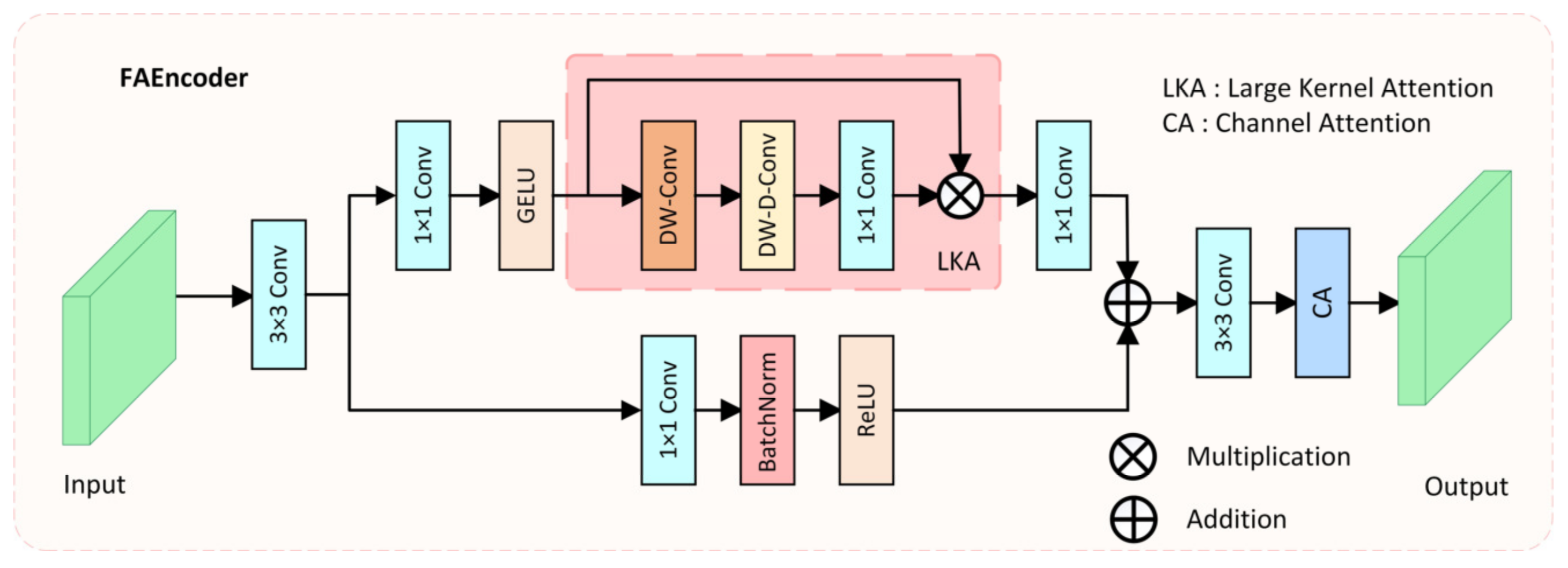


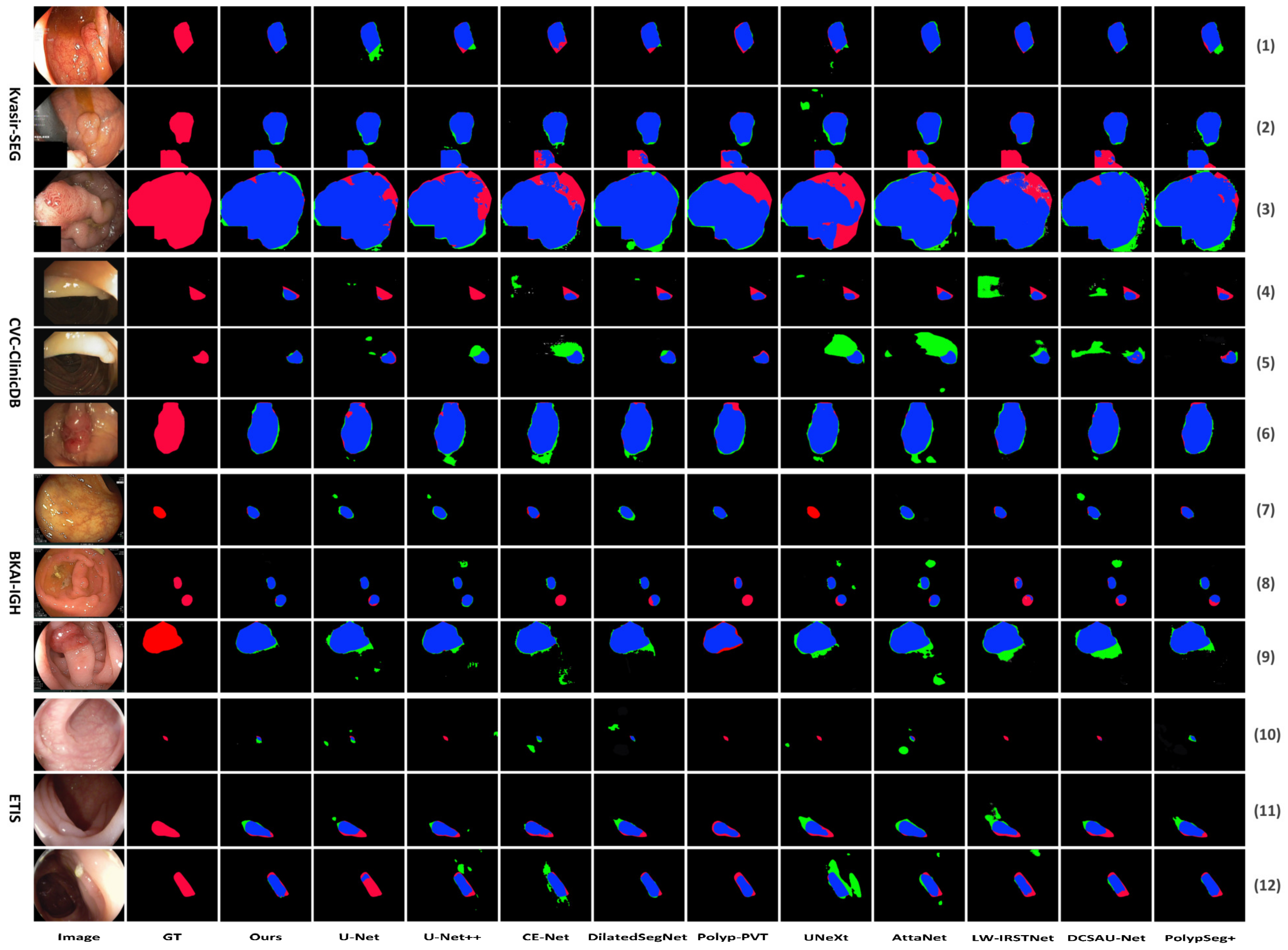
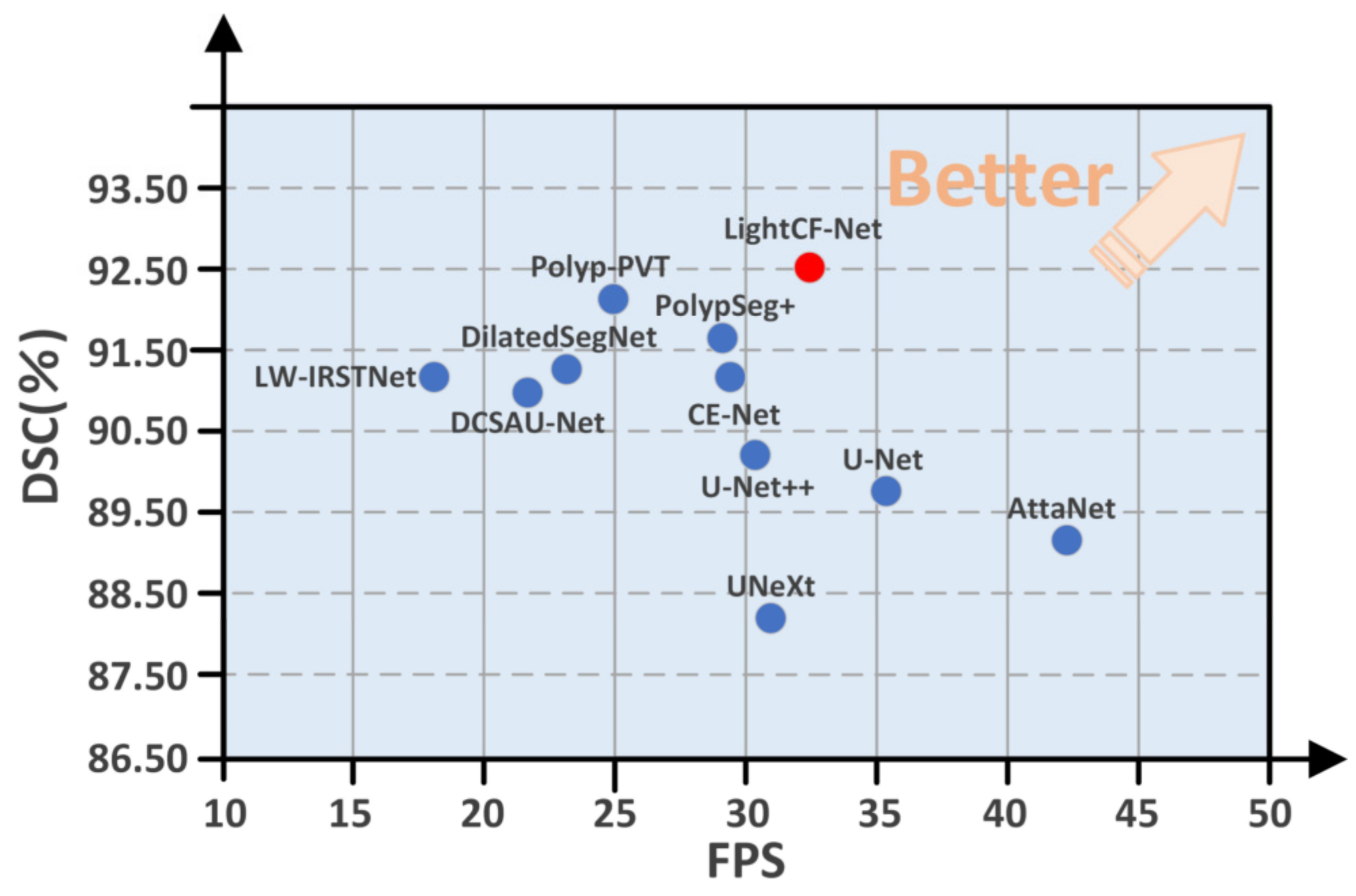
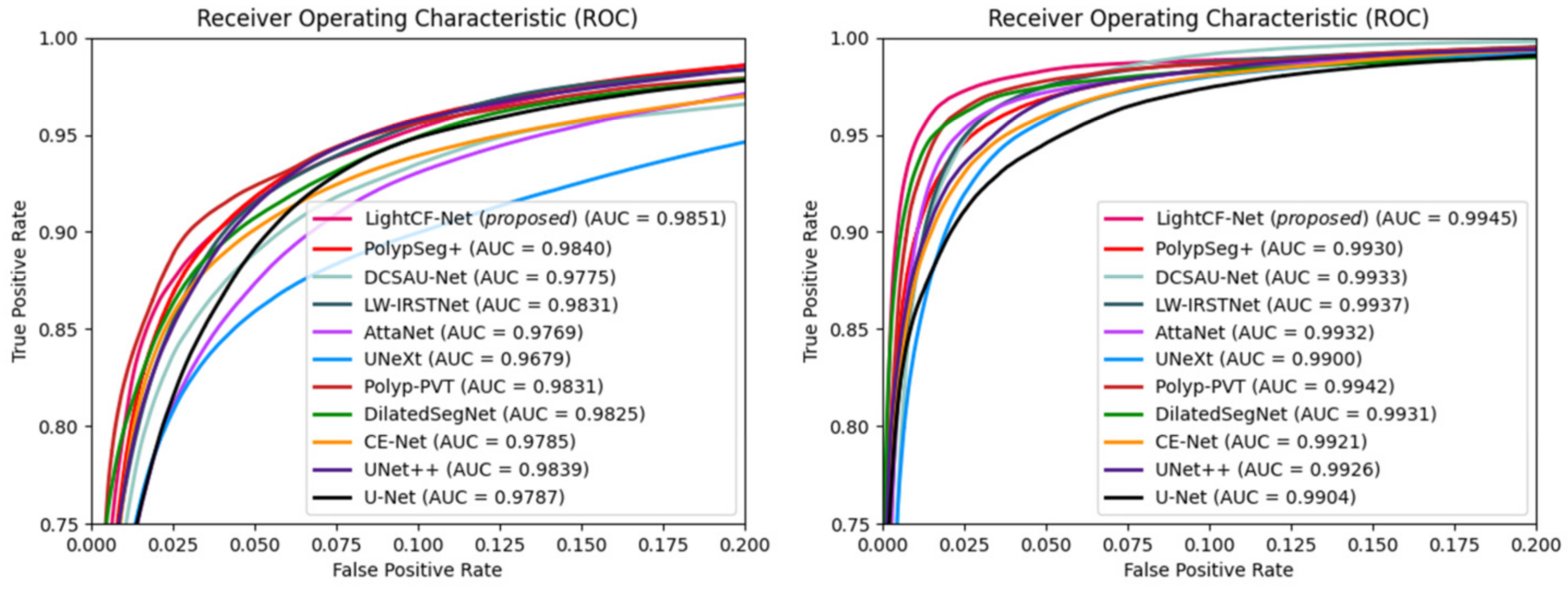
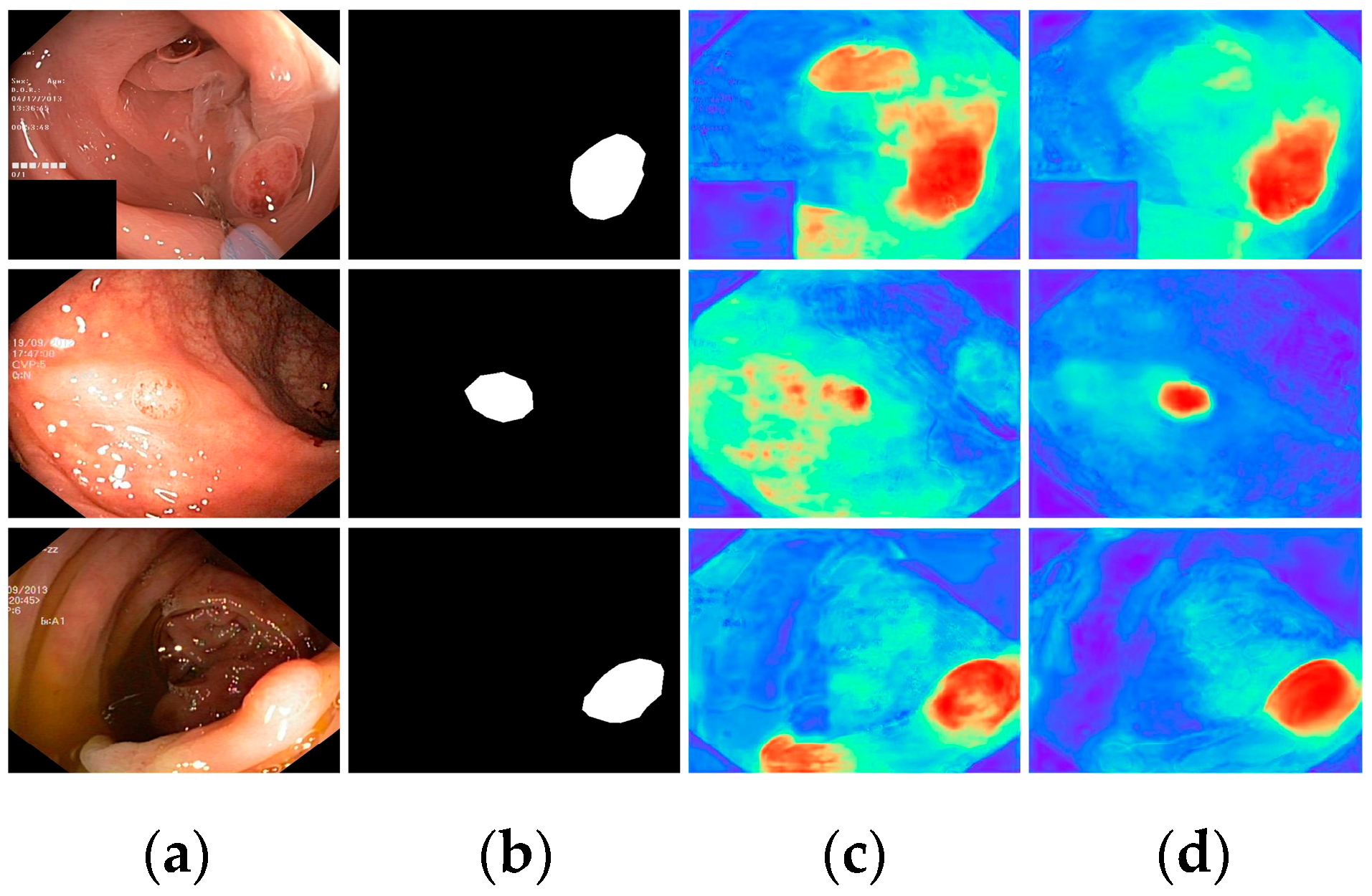

| Method | Kvasir-SEG | CVC-ClinicDB | ||||||||
|---|---|---|---|---|---|---|---|---|---|---|
| IoU (%) | DSC (%) | SE (%) | SP (%) | ACC (%) | IoU (%) | DSC (%) | SE (%) | SP (%) | ACC (%) | |
| U-Net | 75.98 | 86.35 | 85.01 | 97.49 | 95.32 | 81.33 | 89.70 | 87.82 | 99.06 | 98.28 |
| U-Net++ | 76.10 | 86.43 | 85.11 | 97.50 | 95.34 | 82.47 | 90.39 | 88.56 | 98.94 | 98.39 |
| CE-Net | 76.74 | 86.84 | 84.30 | 97.92 | 95.54 | 83.89 | 91.24 | 93.69 | 98.91 | 98.46 |
| DilatedSegNet | 77.16 | 87.11 | 85.36 | 97.48 | 95.54 | 84.16 | 91.40 | 93.15 | 99.00 | 98.50 |
| Polyp-PVT | 77.75 | 87.48 | 82.79 | 98.23 | 95.87 | 85.27 | 92.05 | 88.48 | 99.05 | 98.69 |
| UNeXt | 72.42 | 84.00 | 80.04 | 97.78 | 94.69 | 78.87 | 88.19 | 88.99 | 98.80 | 97.96 |
| AttaNet | 72.51 | 84.07 | 81.43 | 97.40 | 94.62 | 80.48 | 89.19 | 91.76 | 98.69 | 98.10 |
| LW-IRSTNet | 76.25 | 86.52 | 82.76 | 98.20 | 95.51 | 83.95 | 91.27 | 92.97 | 99.00 | 98.48 |
| DCSAU-Net | 76.74 | 86.84 | 83.37 | 98.17 | 95.59 | 83.80 | 91.19 | 90.67 | 99.13 | 98.50 |
| PolypSeg+ | 77.14 | 87.03 | 83.28 | 98.32 | 95.70 | 84.27 | 91.48 | 90.95 | 99.04 | 98.55 |
| Ours | 78.65 | 88.05 | 84.83 | 98.34 | 95.99 | 86.09 | 92.52 | 93.81 | 99.16 | 98.70 |
| Method | BKAI-IGH | ETIS | ||||||||
|---|---|---|---|---|---|---|---|---|---|---|
| IoU (%) | DSC (%) | SE (%) | SP (%) | ACC (%) | IoU (%) | DSC (%) | SE (%) | SP (%) | ACC (%) | |
| U-Net | 73.52 | 84.74 | 82.30 | 99.40 | 98.58 | 61.35 | 76.04 | 67.17 | 99.14 | 98.87 |
| U-Net++ | 74.62 | 85.47 | 85.90 | 99.17 | 98.58 | 63.90 | 77.97 | 77.25 | 99.03 | 98.84 |
| CE-Net | 74.89 | 85.64 | 82.11 | 99.51 | 98.67 | 64.28 | 78.25 | 79.05 | 99.17 | 98.83 |
| DilatedSegNet | 75.12 | 85.79 | 83.53 | 99.44 | 98.67 | 65.47 | 78.96 | 86.67 | 99.13 | 98.82 |
| Polyp-PVT | 75.78 | 86.22 | 83.09 | 99.45 | 98.80 | 66.74 | 80.05 | 86.15 | 99.19 | 98.89 |
| UNeXt | 66.19 | 79.66 | 78.52 | 99.06 | 98.08 | 56.33 | 72.06 | 76.33 | 99.03 | 98.42 |
| AttaNet | 70.06 | 82.40 | 82.77 | 99.09 | 98.30 | 60.48 | 75.37 | 87.63 | 98.77 | 98.47 |
| LW-IRSTNet | 73.65 | 84.83 | 84.16 | 99.37 | 98.58 | 63.78 | 77.88 | 86.37 | 99.01 | 98.68 |
| DCSAU-Net | 74.70 | 85.52 | 85.75 | 99.25 | 98.61 | 64.81 | 78.64 | 76.34 | 99.16 | 98.89 |
| PolypSeg+ | 77.19 | 87.14 | 85.26 | 99.28 | 98.61 | 65.66 | 79.21 | 87.09 | 99.18 | 98.85 |
| Ours | 79.02 | 88.28 | 85.79 | 99.57 | 98.91 | 68.00 | 80.95 | 86.41 | 99.26 | 98.92 |
| Method | Params (M) | FLOPs (G) | FPS |
|---|---|---|---|
| U-Net [13] | 7.24 | 12.16 | 36 |
| U-Net++ [52] | 9.16 | 34.7 | 31 |
| CE-Net [53] | 3.12 | 3.32 | 29 |
| DilatedSegNet [54] | 2.88 | 10.14 | 23 |
| Polyp-PVT [34] | 3.65 | 1.79 | 25 |
| UNeXt [55] | 1.47 | 0.57 | 32 |
| AttaNet [56] | 1 | 1.64 | 43 |
| LW-IRSTNet [57] | 2.48 | 8.91 | 22 |
| DCSAU-Net [58] | 2.59 | 13.83 | 18 |
| PolypSeg+ [17] | 2.54 | 7.23 | 28 |
| LightCF-Net (Ours) | 1.52 | 3.25 | 33 |
| Method | Params (M) | FLOPs (G) | IoU (%) | DSC (%) | SE (%) | SP (%) | ACC (%) |
|---|---|---|---|---|---|---|---|
| Baseline | 0.97 | 2.67 | 74.49 | 85.38 | 82.29 | 97.79 | 95.09 |
| Baseline + FAEncoder_w/o_CA | 1.15 | 2.97 | 75.61 | 86.11 | 82.87 | 97.97 | 95.34 |
| Baseline + FAEncoder | 1.16 | 2.97 | 76.65 | 86.78 | 83.83 | 98.02 | 95.55 |
| Baseline + VAM | 1.21 | 2.91 | 76.67 | 86.80 | 84.28 | 97.63 | 95.48 |
| Baseline + FAEncoder + VAM | 1.40 | 3.22 | 77.83 | 87.53 | 84.60 | 98.16 | 95.80 |
| Baseline (PSA) + FAEncoder + VAM | 1.52 | 3.25 | 78.65 | 88.05 | 84.83 | 98.34 | 95.99 |
Disclaimer/Publisher’s Note: The statements, opinions and data contained in all publications are solely those of the individual author(s) and contributor(s) and not of MDPI and/or the editor(s). MDPI and/or the editor(s) disclaim responsibility for any injury to people or property resulting from any ideas, methods, instructions or products referred to in the content. |
© 2024 by the authors. Licensee MDPI, Basel, Switzerland. This article is an open access article distributed under the terms and conditions of the Creative Commons Attribution (CC BY) license (https://creativecommons.org/licenses/by/4.0/).
Share and Cite
Ji, Z.; Li, X.; Liu, J.; Chen, R.; Liao, Q.; Lyu, T.; Zhao, L. LightCF-Net: A Lightweight Long-Range Context Fusion Network for Real-Time Polyp Segmentation. Bioengineering 2024, 11, 545. https://doi.org/10.3390/bioengineering11060545
Ji Z, Li X, Liu J, Chen R, Liao Q, Lyu T, Zhao L. LightCF-Net: A Lightweight Long-Range Context Fusion Network for Real-Time Polyp Segmentation. Bioengineering. 2024; 11(6):545. https://doi.org/10.3390/bioengineering11060545
Chicago/Turabian StyleJi, Zhanlin, Xiaoyu Li, Jianuo Liu, Rui Chen, Qinping Liao, Tao Lyu, and Li Zhao. 2024. "LightCF-Net: A Lightweight Long-Range Context Fusion Network for Real-Time Polyp Segmentation" Bioengineering 11, no. 6: 545. https://doi.org/10.3390/bioengineering11060545
APA StyleJi, Z., Li, X., Liu, J., Chen, R., Liao, Q., Lyu, T., & Zhao, L. (2024). LightCF-Net: A Lightweight Long-Range Context Fusion Network for Real-Time Polyp Segmentation. Bioengineering, 11(6), 545. https://doi.org/10.3390/bioengineering11060545








